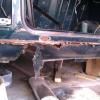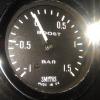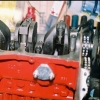Well, I 'll try and tell the story in other words:
When the inlet gas is burned after the spark has come from the sparkplug, the piston goes down. The piston rings are trying their best to seal the piston against the cilinder wall. But still there is passing a bit of burnt gas between piston and cilinderwall into the crankcase. (Blow by).
So, when the ingenieers had not done anything to that, the pressure in the crankcase would build up. So, they arranged a crankcase ventilation system. Behind the engine -on the tappet case- they made an cannister where the burnt gasses can come out of the crankcase. To avoid that too much oil comes with these gasses, they made a separator.
To get a 'positive crankscase ventilation' they putted a tube on top of the separator and connected this to the foot of the carburettor, so that the light vacuüm -that is ther- should suck the burnt gasses out of the crankcase. With a little depression in the crankcase the oil has more difficulty to get passed the oil seals on the crank, as well.
As said above, people who do not understand this system put an filter on the end of the tube, like they have seen on pictures of racing cars. The filter is ment to withstand dust to get into the drankcase. Point is namely that those race guys use the suction that is in the inlet manifold, that is a lot stronger than at the foot of the carburettor, to ventilate the crankcase.
The 'smoke' that you saw coming out of the filter is partly waterdamp. When you burn fuel, a part of the 'smoke' is water. You have seen that on cold mornings after starting your engine, the exhaust is spelling 'white smoke' (waterdamp). As soon as the exhaust is getting hot, the waterdamp does not condensate immediately, so that the smoke becomes colorless. When this waterdamp from the blow by remains in the crankcase it emulgates with the oil and forms white or black suldge as you can find inside the rockerbox of your car when you only drive short distanties, where by the engine does not come on 'working temperature'.
 20151118_001.jpg 78.82K
74 downloads
20151118_001.jpg 78.82K
74 downloads 20151118_002.jpg 71.82K
42 downloads
20151118_002.jpg 71.82K
42 downloads 20151118_003.jpg 65.65K
27 downloads
20151118_003.jpg 65.65K
27 downloads 20151118_004.jpg 66.74K
20 downloads
20151118_004.jpg 66.74K
20 downloads


























